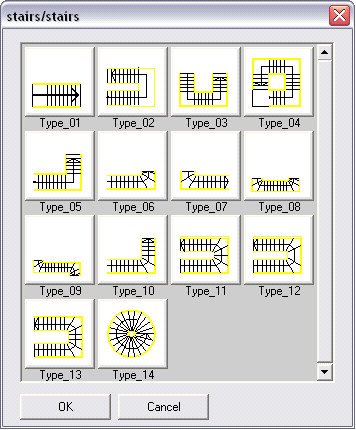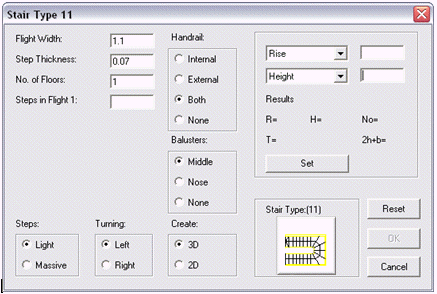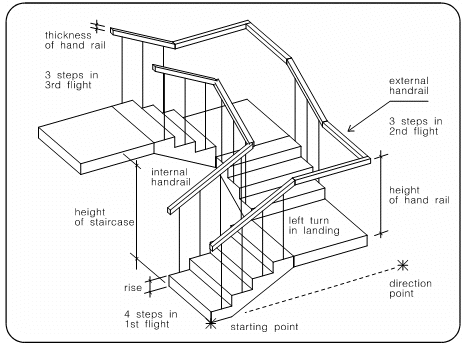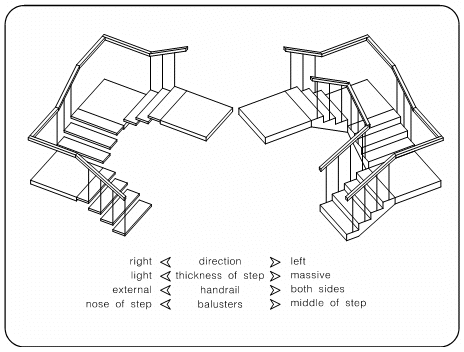Creating Linear Staircases
Home > 07 Stairs > Creating Linear Staircases
Creating Linear Staircases
Create 2D or 3D linear staircases.
\strcs
You can operate this command either via a dialog box or by a series of prompts via the keyboard.
If you use the dialog box:
Choose the type of staircases you wish to create, from the 14 types available:

Then define the parameters of the model you have selected:

If you are working via the keyboard, choose the type of staircase and then specify the number of the staircase model.
Linear (straight flights) models 1-5
Winding models 6-13
Spiral See Creating spiral staircases.
Define the starting point of the staircase and a second point to determine the direction of the stairs. The projection of the line between the two points on the XY plane is the direction of the stairs (upwards). Then specify the width of the flight.
If you are working via the dialog box, you are required to specify these two points after setting the parameters in the dialog box. The width of the stairs is specified in the dialog box.
Choose which stair parameter you want to be the first fixed parameter and specify its value. You can choose from the following:
Rise of step
Tread of step
Height of staircase
Length of staircase
End point of staircase (via keyboard only)
Number of steps in the flight
Depending on the first fixed parameter you choose, you are presented with the options for the second fixed parameter. These are shown in the following table. Choose one and specify its value.
The program calculates the complete set of parameters for the staircase and displays the results in the dialog box or on the input line. If the second fixed parameter is modified, the system informs you by: adding an approximation (~) sign in the input line, if you are working via the keyboard; or by adding the words rounded results to the dialog box.
Check all the parameters. If they suit your design, confirm the solution. If not, reject the solution and change one or both of the parameters.
For example, if you entered height = 3m as a first parameter and rise = 0.17m as the second, you may use:
17 stairs and a 0.176470m rise or
18 stairs and a 0.16667m rise
|
If you choose: |
Second Fixed Parameter Options: |
|
Rise of step |
Height |
|
|
Length (model 1 only) |
|
|
End point |
|
|
Number of steps |
|
Tread of step |
Height |
|
|
Length (model 1 only) |
|
|
End point |
|
|
Number of steps |
|
Height of staircase |
Rise |
|
|
Tread |
|
|
Length |
|
|
End point |
|
|
Number of steps |
|
Length of staircase |
Rise |
|
(model 1 only) |
Tread |
|
|
Height |
|
|
End point |
|
|
Number of steps |
|
End point of staircase |
Rise |
|
(available only via keyboard) |
Tread |
|
|
Number of steps |
|
Number of steps in the flight |
Rise |
|
|
Tread |
|
|
Height |
|
|
Length (model 1 only) |
|
|
End point |
Both answers are appropriate for 3m height and approximate the rise you specified. If the first solution contains 17 stairs and you want 18, do not confirm the parameters. Re-enter height = 3 as the first parameter and the number of stairs = 18 as the second one. This gives you full control over the design of the staircase.
Specify the number of floors. The stair model is created for each floor vertically above each other.
In staircases consisting of more than one flight, the number of stairs can be divided unequally between the flights. Depending on the number of flights in the stair model you specify, define the number of steps in each flight.
models 2, 5, 10, 11, 12 Specify the number of steps in the first flight.
models 3 & 13 Specify the number of steps in the first and second flights.
model 4 Specify the number of steps in the first, second and third flights.
The system reminds you of the number of steps in the entire staircase. In each case the last flight is assumed to contain the remaining steps.

If you choose the model 2 staircase, specify the distance between the two flights.
Choose the type of step that you want:
Light
Massive
If you choose light, specify the step and landing thickness.
Specify the type of handrail:
Internal (In model 1 - left)
External (In model 1 - right)
Both
None
Specify whether you want balusters and their location:
Middle of step
Nose of step
None
Specify the turning direction of the first turn (except in the case of model 1).
Specify whether the result is a 3D model or 2D representation.

